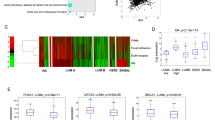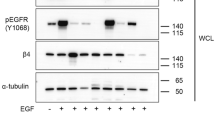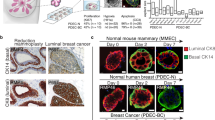Abstract
The expression of estrogen receptor alpha (ERα) is generally associated with a less invasive and aggressive phenotype in breast carcinoma. In an attempt to understand the role of ERα in regulating breast cancer cells invasiveness, we have demonstrated that cell adhesion on fibronectin (Fn) and type IV Collagen (Col) induces ERα-mediated transcription and reduces cell migration in MCF-7 and in MDA-MB-231 cell lines expressing ERα. Analysis of deleted mutants of ERα indicates that the transcriptional activation function (AF)-1 is required for ERα-mediated transcription as well as for the inhibition of cell migration induced by cell adhesion on extracellular matrix (ECM) proteins. In addition, the nuclear localization signal region and some serine residues in the AF-1 of the ERα are both required for the regulation of cell invasiveness as we have observed in HeLa cells. It is worth noting that c-Src activation is coincident with adhesion of cells to ECM proteins and that the inhibition of c-Src activity by PP2 or the expression of a dominant-negative c-Src abolishes ERα-mediated transcription and partially reverts the inhibition of cell invasiveness in ERα-positive cancer cells. These findings address the integrated role of ECM proteins and ERα in influencing breast cancer cell motility through a mechanism that involves c-Src and seems not to be related to a specific cell type.
This is a preview of subscription content, access via your institution
Access options
Subscribe to this journal
Receive 50 print issues and online access
$259.00 per year
only $5.18 per issue
Buy this article
- Purchase on Springer Link
- Instant access to full article PDF
Prices may be subject to local taxes which are calculated during checkout








Similar content being viewed by others
Abbreviations
- AF-1:
-
estrogen receptor activation function 1
- AF-2:
-
estrogen receptor activation function 2
- Col:
-
type IV collagen
- ECM:
-
extracellular matrix
- ERα:
-
estrogen receptor alpha
- ERβ:
-
estrogen receptor beta
- Fn:
-
fibronectin
- ERE:
-
estrogen-responsive element
- c-Src(+):
-
c-Src
- Src(−):
-
dominant negative of c-Src
References
Abbas Abidi SM, Howard EW, Dmytryk JJ and Pento JT . (1997). Clin. Exp. Metast., 15, 432–439.
Amundadottir LT and Leder P . (1998). Oncogene, 16, 737–746.
Aplin AE and Juliano RL . (1999). J. Cell Sci., 112, 695–706.
Arnold SF, Vorojeikina DP and Notides AC . (1995). J. Biol. Chem., 270, 30205–30212.
Aronica SM, Kraus WL, Katzenellenbogen BS and Power RF . (1994). Proc. Natl. Acad. Sci. USA, 91, 8517–8521.
Bunone G, Briand PA, Miksicek RJ and Picard D . (1996). EMBO J., 15, 2174–2183.
Cary LA, Han DC, Polte TR, Hanks SK and Guan JL . (1998). J. Cell Biol., 140, 211–221.
Chalbos D, Philips A, Galtier F and Rochefort H . (1993). Endocrinology, 133, 571–576.
Chen Q, Kinch MS, Lin TH, Burridge K and Juliano RL . (1994). J. Biol. Chem., 6, 26602–26605.
Clark EA and Brugge JS . (1995). Science, 268, 233–239.
Couse JF, Curtis SW, Washburn TF, Eddy EM, Schomberg DW and Korach KS . (1995). Biochem. Soc. Trans., 23, 929–935.
Crowe DL and Brown TN . (1999). Neoplasia, 1, 368–372.
Doerr ME and Jones JI . (1996). J. Biol. Chem., 271, 2443–2447.
Feng W, Webb P, Nguyen P, Liu X, Li J, Karin M and Kushner PJ . (2001). Mol. Endocrinol., 15, 32–45.
Fraker LD, Halter SA and Forbes JT . (1984). Cancer Res., 44, 5757–5763.
Giancotti F and Ruoslahti E . (1999). Science, 285, 1028–1032.
Guan JL . (1997). Int. J. Biochem. Cell Biol., 29, 1085–1096.
Guy CT, Muthuswamy SK, Cardiff RD, Soriano P and Muller WJ . (1994). Genes Dev., 8, 23–32.
Hayashido Y, Lucas A, Rougeot C, Godyna S, Argraves WS and Rochefort H . (1998). Int. J. Cancer, 75, 654–658.
Hynes RO . (1990). Fibronectins. Springer: New York.
Ignar-Trowbridge DM, Pimentel M, Teng CT, Korach KS and McLachlan JA . (1995). Environ. Health Perspect., 103, 35–38.
Irby RB and Yeatman TJ . (2000). Oncogene, 19, 5636–5642.
Joel PB, Traish AM and Lannigan DA . (1998). J. Biol. Chem., 273, 13317–13323.
Kaplan KB, Swedlow JR, Morgan DO and Varmus HE . (1995). Genes Dev., 9, 1505–1517.
Kato S, Endoh H, Masuhiro Y, Kitamoto T, Uchiyama S, Sasaki H, Masushige S, Gotoh Y, Nishida E, Kawashima H, Metzger D and Chambon P . (1994). Science, 270, 1491–1494.
Klemke RL, Leng J, Molander R, Brooks PC, Vuori K and Cheresh DA . (1998). J. Cell Biol., 140, 961–972.
Lazennec G, Bresson D, Lucas A, Chauveau C and Vignon F . (2001). Endocrinology, 142, 4120–4130.
Lehrer S, O'Shaughnessy J, Song HK, Levine E, Savoretti P, Dalton J, Lipsztein R, Kalnicki S and Bloomer WD . (1989). Mt. Sinai. J. Med., 56, 83–85.
Lin TH, Chen Q, Howe A and Juliano RL . (1997). J. Biol. Chem., 272, 8849–8852.
Liotta LA, Stracke ML, Aznavoorian SA, Beckner ME and Schiffmann E . (1991). Semin. Cancer Biol., 2, 111–114.
Lowell CA, Fumagalli L and Berton G . (1996). J. Cell. Biol., 133, 895–910.
Maa MC, Leu TH, McCarley DJ, Schatzman RC and Parsons SJ . (1995). Proc. Natl. Acad. Sci. USA, 92, 6981–6985.
McGuire WL . (1986). Cancer Surveys: Hormone Receptors Breast Cancer Vol. 5. Bulbrook RD (ed). Oxford University Press: Oxford, pp. 527–536.
Miyamoto S, Teramoto H, Gutkind JS and Yamada KM . (1996). J. Cell Biol., 135, 1633–1642.
Morino N, Mimura T, Hamasaki K, Tobe K, Ueki K, Kikuchi K, Takehara K, Kadowaki T, Yazaki Y and Nojima Y . (1995). J. Biol. Chem., 270, 269–273.
Muthuswamy SK, Siegel PM, Dankort DL, Webster MA and Muller WJ . (1994). Mol. Cell. Biol., 14, 735–743.
Osborne CK, Hobbs K and Clark GM . (1985). Cancer Res., 45, 584–590.
Petit V, Boyer B, Lentz D, Turner CE, Thiery JP and Valles AM . (2000). J. Cell Biol., 148, 957–970.
Platet N, Cunat S, Chalbos D, Rochefort H and Garcia M . (2000). Mol. Endocrinol., 14, 999–1009.
Power RF, Mani SK, Codina J, Conneely OM and O' Malley BW . (1991). Science, 254, 1636–1639.
Price JE, Polyzos A, Zhang RD and Daniels LM . (1990). Cancer Res., 50, 717–721.
Renshaw MW, Ren XD and Schwartz MA . (1997). EMBO J., 16, 5592–5599.
Rochefort H, Platet N, Hayashido Y, Derocq D, Lucas A, Cunat S and Garcia M . (1998). J. Steroid Biochem. Mol. Biol., 65, 163–168.
Schaller MD, Hildebrand JD and Parsons JT . (1999). Mol. Cell. Biol., 10, 3489–3505.
Schlaepfer DD, Broome MA and Hunter T . (1997). Mol. Cell. Biol., 17, 1702–1713.
Schlaepfer DD, Hanks SK, Hunter T and Van der Geer P . (1994). Nature, 372, 786–791.
Schlaepfer DD and Hunter T . (1996). Mol. Cell. Biol., 16, 5623–5633.
Sheffield LG . (1998). Biochem. Biophys. Res. Commun., 250, 27–31.
Suen PW, Ilic D, Caveggion E, Berton G, Damsky CH and Lowell CA . (1999). J. Cell Sci., 112, 4067–4078.
Summy JM and Gallick GE . (2003). Cancer Metast. Rev., 22, 337–358.
Thompson EW, Paik S, Brunner N, Sommers CL, Zugmaier G, Clarke R, Shima TB, Torri J, Donahue S, Lippman ME, Martin GR and Dixon RB . (1992). J. Cell. Physiol., 150, 534–544.
Tora L, Mullick A, Metzger D, Ponglikitmongkol M, Park I and Chambon P . (1989). EMBO J., 8, 1981–1986.
Weigel N . (1996). Biochem. J., 319, 657–667.
Zhu X and Assoian RK . (1995). Mol. Cell. Biol., 6, 273–282.
Acknowledgements
We thank Dr Didier Picard for kindly providing XETL, pSG5-HeG0, pSG5-HE15 and pSG5-HE19 plasmids, Dr Joan Brugge for generously providing pCMV-cSrc-K295R, Y527F plasmid, Dr Douglas D Boyd for helpfully providing pcDNA3-c-Src/Y527F plasmid, Dr Deborah A Lannigan for kindly providing pcDNA3/ER-S104/S106/S118/A plasmid and Dr Robert XD Song for helpfully providing hE241G/pCMV plasmid. This work was supported by Grant ‘AIRC 2001’.
Author information
Authors and Affiliations
Corresponding author
Rights and permissions
About this article
Cite this article
Sisci, D., Aquila, S., Middea, E. et al. Fibronectin and type IV collagen activate ERα AF-1 by c-Src pathway: effect on breast cancer cell motility. Oncogene 23, 8920–8930 (2004). https://doi.org/10.1038/sj.onc.1208098
Received:
Revised:
Accepted:
Published:
Issue Date:
DOI: https://doi.org/10.1038/sj.onc.1208098
Keywords
This article is cited by
-
Ovarian and Breast Cancer Migration Dynamics on Laminin and Fibronectin Bi-directional Gradient Fibers Fabricated via Multiphoton Excited Photochemistry
Cellular and Molecular Bioengineering (2017)
-
Loss of heterozygosity of chromosome 13q33-34 region and molecular analysis of ING1 and p53 genes in bladder carcinoma
Molecular Biology Reports (2015)
-
E-cadherin promotor methylation and mutation are inversely related to motility capacity of breast cancer cells
Breast Cancer Research and Treatment (2012)
-
Microdialysis Combined with Proteomics for Protein Identification in Breast Tumor Microenvironment In Vivo
Cancer Microenvironment (2011)
-
17β-Estradiol enhances α5 integrin subunit gene expression through ERα–Sp1 interaction and reduces cell motility and invasion of ERα-positive breast cancer cells
Breast Cancer Research and Treatment (2010)



